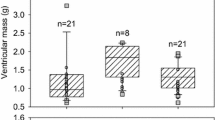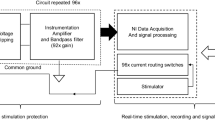Abstract
The functional relationship between heart rate, under atrial pacing, and the intensity of pacing pulses, was determined for intensities ranging from well below the complete heart rate capture threshold to suprathreshold intensities. A separate capture-intensity function was determined for each of the pacing frequencies 180, 240, 300 and 360 pulses per min, and then used to evaluate the effects of propranolol hydrochloride and atropine sulfate on atrial pacing. Propranolol resulted in an increase in the amount of current (mA) required to achieve a given degree of cardiac capture, whereas atropine resulted in a decrease. These shifts in the capture-intensity functions along the intensity axis were possibly caused by drug antagonism of betaadrenergic and cholinergic receptors, respectively, although the effects might also have been due to modifications of the electrical responsivity of the cardiac muscle, independently of the neural blockade.
Similar content being viewed by others
References
Benfey, B. G. and Vanna, D. R.: Antisympathomimetic and antifibrillatory effects of pronethalol and propranolol.Br. J. Pharmacol. 26:3, 1966.
Innes, I. R. and Nickerson, M.: Drugs inhibiting the action of acetylcholine on structures innervated by postganglionic parasympathetic nerves (antimuscarinic or atropinic drugs),In L. S. Goodman and A. Gilman (Eds.):The Pharmacological Basis of Therapeutics, 4th ed., London, The MacMillan Company, 1970.
Kadden, R. M., Schoenfeld, W. N., and Snapper, A. G.: Cardiac pacing in the rhesus monkey: A technique and some behavioral data.Proc, 78th Ann. Conv., Am. Psychol. Assn.,5:259, 1970.
Kadden, R. M., Snapper, A. G., Schoenfeld, W. N., and Kop, P. F. M.: Transvenous intracardiac pacing in the rhesus monkey.Comm. Behav. Biol.,5:255, 1970.
Kosman, M. E.: Current status of propranolol hydrochloride (Inderal).JAMA,225:1380, 1973.
Lucchesi, B. R., Whitsitt, L. S., and Stickney, J. L.: Antiarrythmic effects of beta-adrenergic blocking agents.Ann. N. Y. Acad. Sci.,139:940, 1967.
Preston, T. A., Fletcher, R. D., Lucchesi, B. R. and Judge, R. D.: Changes in myocardial threshold. Physiologic and pharmacologic factors in patients with implanted pacemakers.Am. Heart J.,74:235, 1967.
Rosati, R. A., Alexander, J. A., Wallace, A. G., Sealy, W. C., and Young, W. G.: Failure of beta-adrenergic blockade to alter ventricular fibrillation threshold in the dog.Circ. Res.,19:721, 1966.
Author information
Authors and Affiliations
Additional information
This study was supported by Grant MH-13049 from the National Institute of Mental Health, USPHS, and the Veterans Administration Hospital (Project Number 7659-01), Montrose, New York 10548, USA.
Rights and permissions
About this article
Cite this article
Schoenfeld, W.N., Kadden, R.M. & McMlllan, J.C. Effectiveness of atrial pacing inMacaca Mulatta as a function of pacing pulse intensity: Modification by atropine and propranolol. Pav. J. Biol. Sci. 12, 32–40 (1977). https://doi.org/10.1007/BF03001797
Issue Date:
DOI: https://doi.org/10.1007/BF03001797




